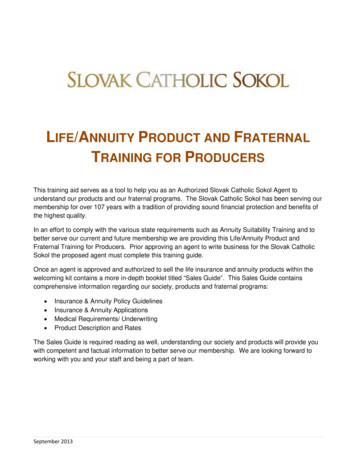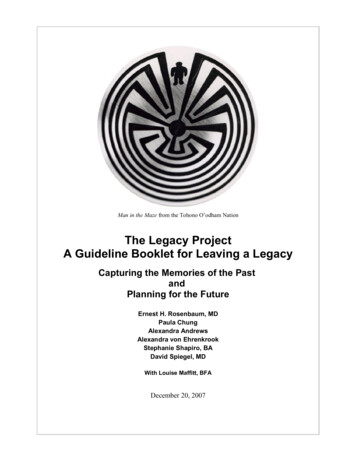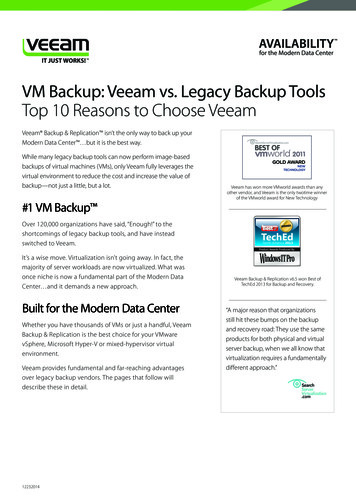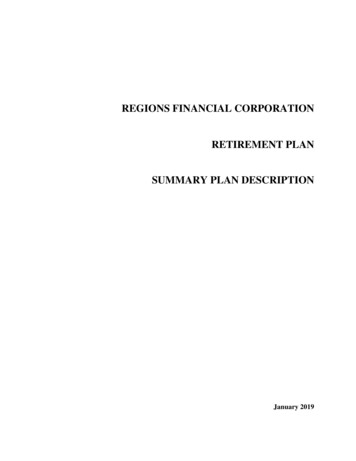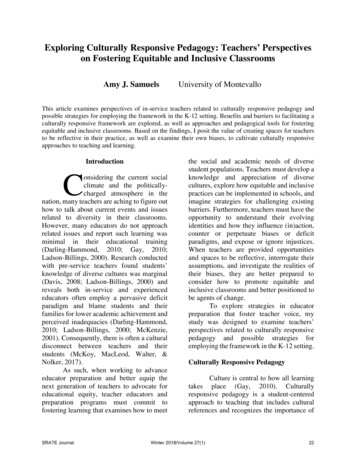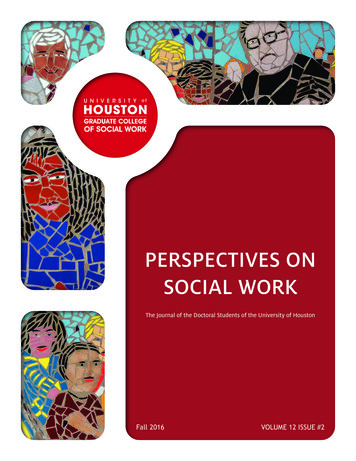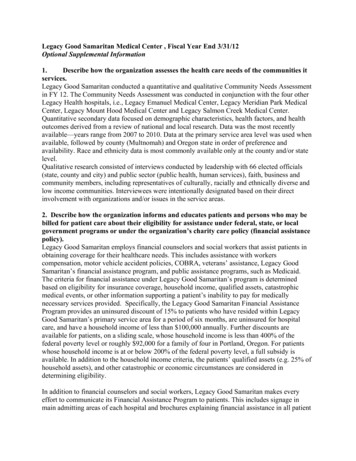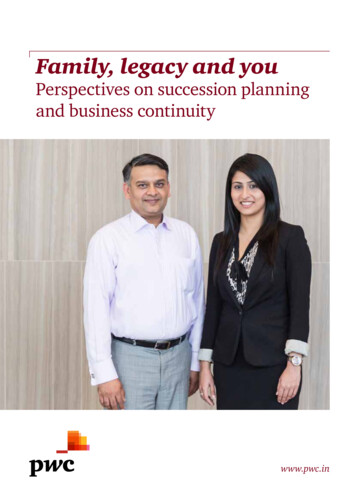
Transcription
Family, legacy and youPerspectives on succession planningand business continuitywww.pwc.in
Contents2PwCFamily businesses: engines of change4Preserving the legacy: why planning succession is critical6Key challenges faced by family businesses8Family governance: tools for success26Family office28Global importance of family businesses32Success of the family and the business33Steps to effective succession planning and business continuity34
ForewordGanesh Raju KPartner and Leader,Entrepreneurial and Private BusinessThese are exciting times for family businesses. Promising new markets beckon and existing markets offer plenty ofprospects for sustained growth and diversification. This is attributed to a combination of favourable factors such asstabilisation of reforms, increase in consumption and demand, increase in investment and an overall positive outlook.By merging ambition with opportunities, family businesses are on an upward growth trajectory.Most Asian family businesses are built on a strong foundation of values, culture and tradition. These are consideredsacrosanct and passed on through generations. Family businesses have a natural insulation to withstand marketirregularities because family members and professionals are unified by a common purpose, which makes them moretolerant for risks as compared to their non-family business counterparts. Family businesses are set up with the objectiveof continuity and take a long-term view of business.Due to the make-up of family business, issues that can put the business at risk are mostly internal and need to bemanaged with a combination of tact and formal structures to ensure stability.Broadly, for a family business, the issues that need to be tackled include the following:Continuity planningEach family has a vision for the future and is fully committed to the success of the business. However, it is very likelythat family members belonging to the current and next generations have conflicting vision and objectives pertainingto the business. It is important to understand the needs of the next generation and how these can be satisfied whilepreserving the vision of continuity. Consequently, it is important for family members to agree on an overall vision aswell as their own convictions.Succession planning and generational changeSuccession is the biggest threat facing all family businesses. The transfer of ownership and planning the succession processis the most difficult challenge that family businesses encounter. If succession and generational change is not properlyaddressed, this could easily result in the fragmentation of family businesses, the impact of which could be catastrophic. Whowill take over the baton? Should non-family members be on the board? Will the business sustain for generations? How andwhen do I pass on my assets to the next generation? There are multiple questions that need to be answered while planning forsuccession of management and ownership. This should not be treated as a one-time event but an evolutionary process.Conflict managementGiven the fabric of a family business, conflicts are inevitable. Managing conflict is the key to not just the survival of thebusiness, but the survival of the family itself. Since there are multiple stakeholders who are invested in the success of thebusiness, it becomes necessary to have a robust resolution mechanism in place to manage potential conflicts. Familiesalso need to identify key areas where conflicts may arise and develop protocols to create unity in dealing with these issuesbefore they arise.Our Family Business and Next Gen surveys have shown that family businesses globally are beginning to realise that successionplanning is a priority and it is necessary to have robust structures and mechanisms to combat the threat of succession. Our indepth conversations with the current and next generation of leading businesses helps get their perspective on their ambitionsfor diversification, modernisation, bringing in professionalism and more. It has been observed that families are increasinglyadopting measures to safeguard the business from internal and external threats and educate the next generation of familymembers. Their vision for the business and views are taken into consideration while crafting a succession planning strategy.We spoke to prestigious Asian family businesses to understand their approach to succession planning, the challenges they faceand how they are tackling the issues surrounding succession. We have also captured their ideologies to give the reader a holisticperspective on the critical issue of succession planning.Perspectives on succession planning and business continuity3
Family businesses: enginesof change“Before the multinational corporation, therewas Family Business. Before the IndustrialRevolution, there was Family Business. Beforethe enlightenment of Greece and the empireof Rome, there was Family Business”Entrepreneurship, ambition, resilience, dynamism,sustainability, legacy—these are some of the terms that aresynonymous with a family business.Family enterprises are key catalysts for growth andintegral to most economies. Operating in markets withsignificant potential, these businesses offer stability to theeconomy, are optimistic about growth, drive job creationand have a long-term view on growth and profitability.William O’HaraAreas that will play a big role in growthGrowing core business inexisting marketsAcquistition(s)45%51%New countries52%This growth is expected to come from its core business andalso from inorganic expansion into new areas and markets.As compared to nonfamily-owned businesses, familybusinesses have been able to weather systemic changesbetter. These are more entrepreneurial in nature thannon-family businesses and the ethos, values and cultureis also much stronger. Family businesses have remainedresilient in the face of domestic and international change,are aggressive and have the potential to withstandbusiness and economic adversities.4PwC85%56%Family businesses are optimistic about growth andcontribute to more than 70% of GDP in spite of concernssuch as inadequate infrastructure, paucity of skills anduncertain economic growth. Our India Family BusinessSurvey 2016 indicated that 75% of Indian familybusinesses have grown in the last 12 months and 84%expect to grow either steadily or quickly and aggressivelyover the next five years.The growth agenda poses a significant challenge for eventhe most entrepreneurial family businesses. As the numberof family members increase across generations, the familybusinesses should also grow by double digits to maintainfamily’s wealth levels for future generations.96%51%New sectors41%IndiaGlobalHowever, family businesses face dual challenges— they operatein a very difficult global economic environment and also haveto manage the transition of the family into the next generation.Despite their ambition and positive outlook, the average life spanacross family businesses is three generations. Only 12% make itto the third generation and as low as 3% to the fourth generation.Insulating family businesses from external and internal threats isvital and calls for alignment of family and business strategy androbust governance structures for both families and businesses.
How family businesses differ from non-family businesses74%Stronger cultures and values72%Measure success differently more than just profit and growth71%Decision making is faster/more streamlined61%More entrepreneurial55%Take a longer term approach todecision making48%Need to work harder to recruit/retain top talent40%Take more risks30%Find it harder to access capitalPerspectives on succession planning and business continuity5
Preserving the legacy: whyplanning succession is criticalIn most family businesses, what starts as anentrepreneurial project turns into an establishment ofconglomerates that employs a substantial percentage ofthe country’s workforce, making them invaluable to theeconomy. Moreover, businesses are going global, whichmeans increased connectivity with global peers and widepenetration into foreign markets, presenting considerableopportunities for growth. In the light of this, it becomescrucial to establish a process that will pick able leaders,who will be torchbearers of the family business.In the India Family Business Survey, we asked respondentswhether the strategy of the business and that of the familywere completely aligned. Our survey revealed that 76% ofIndian family businesses believe that the family and businessstrategies are completely aligned. Only a mere 6% admittedto misalignment in interests.Alignment of family and the business76%Managing family dynamics is delicateand sensitiveOverlapping roles of family members in different positionsin business adds a layer of complexity to its functioning.Decision making with the ‘heart’ over the ‘head’ increaseslikelihood for conflict, shaking strong foundations uponwhich the business was built.Agree to alignment69%17%Neither agree nor disagree20%As one of our interviewees said, “Family businessesgenerally fail for family reasons.”To ensure that personal issues do not interfere withbusiness, open communication, clear documentation ofroles and external advisors are encouraged. Therefore,with the help of a clearly articulated succession plan,family businesses have an increased chance of survivingfor generations.Depending on the position of members in the Three Circlemodel, the roles, duties and expectation of rewards differ.OwnerFamily6PwCExternalmanagersand ningFamilyshares managers/sharesemployees owningsharesFamilyemployees10%IndiaGlobalAlthough there is high degree of alignment between thefamily and business, we have seen that there are three keychallenges that plague the perpetuity of a family business: Continuity planning Succession planning and generational change Conflict ree to alignmentSuccession has its own challenges. Differing views of currentand next generations with respect to the vision and futureof the business, absence of well-defined succession plans,inability to attract external management, keeping pace withthe new developments in the market and technology, etc., aresome of them.
Family businesses are a multigenerational project. Only ifwe succeed in passing on theentrepreneurial responsibility to thenext generation can the project of thefamily business remain aliveBusiness succession also touches upondifficult and at times very personal questionssuch as ownership and leadership, money,power and recognition. Legal and taxissues and an increasing global exposure,compound the complexity that alreadyexists. The solution calls for a deliberate andprofessional approach to the issue.A robust governance policy is essential fora family business to survive for generationsand avoid conflict between family members.According to our Global Family BusinessSurvey, only 15% of family businesses havea robust and documented succession planin place. Given that around 40% of familybusinesses will be passing on the businessto the next generation in the next five years,planning for succession is instrumental toensuring business continuity and keeping thefamily legacy alive.Perspectives on succession planning and business continuity7
Key challenges faced byfamily businessesContinuity planningContinuity planning is vital for perpetuating a family business. It is important that there is alignment of vision andcommitment of all family members to achieve the vision that is set out for the family and the business.Family v. businessIn a family business, very often a question arises, ‘What comes first, family or business?’ The answer to this often drives thevision and how businesses are run and managed.Families, which put the family first, take decisions with the ‘heart’ and emphasises on family harmony. Whereas, families,which prioritise the business, take decisions objectively with the ‘head’ without co-mingling family issues.Family firstBusiness firstDhiren GopalFeatherlite GroupYou can’t grow alone. As afamily we grow together —Leave no one behind!“In 1965 our father Gopal Ramnarayan while on a Rotarygroup exchange programme to the US, was intriguedby the aluminum folding furniture. He saw tremendouspotential and when he returned to India, he started amanufacturing unit for folding garden furniture, made ofaluminum tubes and called it Featherlite.When my brothers and I joined the business, we had avery clear understanding of what was expected fromus and the direction we should head towards. Ourbusiness is very unique and customer satisfaction is thekey. Although we professionalised certain functions, webelieve that R&D, sales and marketing will require activeinvolvement of family members.When we ventured into real estate, my eldest brotherJawahar took complete ownership of that businessalong with continuing handling our investments and allfinancial matters. My middle brother Manohar was giventhe responsibility of marketing and sales and is involvedin both the real estate and furniture business equally.8PwCHusein EsufallyHemas GroupWhat is best for the businessis best for the family“Our grandfather was a man of great foresight andentrepreneurship. He set up his own business aftermoving out of the existing family business.By the 1960s, the second generation, comprisinghis four sons, joined the business and continued theentrepreneurial spirit to develop and expand the businessand by the 1970s and 80s, the third generation wereready to come in and make their own mark.Going public and professionalising was not a visionshared by my two uncles and in 2000 they sold their shareto the third generation—Abbas, Imtiaz, Murtaza and mein equal proportion.In 2001, I was appointed as the Group CEO and theother members of the family took on the role of drivingdifferent verticals of the business. In 2003, with theobjective of sustaining the business, we embarked on ajourney and successfully took the company public.
I was put in charge of manufacturing and R&D alongwith the task of technology up-gradation-in our plants.Although our responsibilities were well demarcatedand we have our roles and responsibilities clearlydefined, in terms of ownership we were all equal. Weshare all profits and losses equally and realized earlyon that in a joint family business the upside of beingtogether and working together is always more than thedownside. I sincerely believe that key to the success ofour business is the implicit faith, respect and trust wehave in each other.We also firmly believe that it is not ‘who is right’ but‘what is right’. This attitude that we all carry in ourhearts and minds helps us work together and livetogether in harmony at work and at home. As a policywe do not interfere in each other’s daily roles andresponsibilities and give each other ample space to takeindependent decisions in our areas of designated rolesand responsibilities, this noninterference is probablythe biggest contribution we make to each other’sgrowth and success.This doesn’t mean we do not question one anotheror seek advice on matters of importance or trivialirritations. We all know that each one of us isalways available for sounding out new ideas, airingfrustrations, and sharing successes.Professionalising the business is something the entirefamily needs to buy into and it cannot be just oneperson’s vision. It is a journey and we decide, whichdirection the family wants to head towards.We recognised early on that we, as family members,can drive things only to a certain extent and taking thecompany public automatically brought in a certain levelof professionalism. We had an independent Board andany differences of opinion within the family, was airedin a Board meeting, which helped us take decisions in arational manner.Moreover, we understood early on the importance ofthe external dimension brought in by professionals andappointed an external CEO. We became stewards toensure the future success of the family business.For effective governance of the business, we alsoestablished a Family Constitution, which clearly lays outthe interaction between the family and the business.As a family we understood that every business is uniqueand there is no ‘one size fits all’. Our underlying principleis that ‘business comes first’ and this principle drives allour decisions.”We debrief, debate and deliberate and sometimes evenargue about matters that effect all of us or the businessbut the final decision is left to the person driving thebusiness. We always trust and respect each other’sjudgment even if we may not completely agree with it.At the back of our minds, I know that each and everyone of us takes that leap of faith into the unknown,knowing that the family has his back, should he or shestumble or fall.As a family it’s imperative that we strive to inculcatethe similar values in our children and professionalsworking in the business. We are now in the process offormalizing our Family Constitution and governanceframework so that all our values and ideologies areformalized and passed on for next generations as well.‘Love All Serve All’ is a motto our family stronglybelieves in. For us, it is and always will be, ‘familycomes first’ and all our decisions are taken keeping inmind our family principles and beliefs.”Perspectives on succession planning and business continuity9
Passing on the baton – Journey of NR GroupArjun RangaNR Group“Sustaining and perpetuating a businessthrough family values is essential to itssurvival. Family values is what defines anddrives the business.”Arjun Ranga is the Managing Director of Cycle PureAgarbathies, a brand which is now synonymous with prayerand spirituality.Given that the business is currently managed by the thirdgeneration, we asked Arjun how his family has successfullymanaged transition to the third generation. He explains,“Around the time India got independence, my grandfathersold home products and incense sticks in Mysore. The secondgeneration grew the business on the foundation built by mygrandfather. From a very young age, the second generationencouraged us, the third generation, to be a part of thebusiness discussions. As a young boy I used to accompany myfather to the market for sales and marketing of agarbathis.This exposure helped me understand the family, the businessand most importantly, the distinction between the two.Today, my son accompanies me to office during his summervacations.There were also certain ground rules that were laid downfor the business. From a very young age, my cousins and Iwere made aware of what the family business had to offer interms of perks and travel, provided we chose to be a part ofit. As soon as we turned 18, we were also made aware of ourshareholding in the business. It was an unwritten rule that allthird generation members would need to get a master’s degreeand also, work outside prior to joining the business. We intendto apply the same rules for the incoming generations as well,to ensure they are well equipped when they join the business.Our family also created a path to learn different parts ofthe business and created opportunities to work in differentbusinesses. The second generation had one main business andmy father and uncles were given to manage different verticalsof the business within defined rules. When my cousins andI joined the business, the business had expanded beyondincense sticks and each one of us managed the chosen businessindependently. Moreover, regardless of the size of the business,the salary, allowances and perks available to each member isthe same.”When asked about the role of the third generation in thebusiness, Arjun says “The family gave us a lot of autonomyand independence to drive our respective businesses.10PwCArjun RangaThere was a certain level of trust and safety net of howthe family will support us. We all sit on the Board and areanswerable to each other, but the ultimate decision is left to thejudgement of the family member running a particular business.However, in terms of investment decisions or entering a newbusiness, all decisions are unanimous and everyone has to beon board.” He enunciated the importance of trust amongstthe third generation as family members as well as businesspartners. He agreed that since all decisions need to betaken unanimously, it can sometimes be counterproductive.However, it keeps the family together.Arjun then touched upon an aspect that is a challenge forall family businesses, which is the succession and transitionof power from the senior to the next generation. He says,“Our earlier generation told us ‘you help us structure ourexit rather than we structure your entry.’ Similar to how mygrandfather transitioned the business, my father retired andtook a back seat. He took a minority share in the company andtransferred half his shareholding when I joined the business anddid the same for my brother as well. This gave us tremendousconfidence and belief. We also have a similar plan and haveclearly articulated a phase-wise transition of shareholding tothe fourth generation to encourage them to join the business.”Arjun reiterates that having a clear succession plan iscrucial for the survival of the business as well as ensurestransparency and provides clarity. Some of the importantaspects he emphasised on include having a family governancecode and business succession plan. “There should be a clearretirement policy which includes defining the benefits andshareholding of the senior generation post retirement. Workingbackwards, this should form the basis of how the share andbenefits will be transferred.”Arjun signs off by telling us that, “altruism is the key tosustenance of our family and we understand the meaningof the greater good. Selflessly putting the family first is keyto survival of our business.”
Planning for succession: SRF’s experienceAshish Bharat RamSRFSRF Limited, based out of Gurgaon, manufacturesengineering plastics, chemicals, packaging films andautomotive components.We spoke to Ashish Bharat Ram, the Managing Director ofthe Group, on how his family has planned for succession.Ashish explains, “In the context of a family business, we candraw comparison to the three circle model. The first representsthe family, the second represents owners and the thirdrepresents the management. It is not necessary that a familymember should be present in all the three circles. Being bornin a family and being an owner of the family business is not achoice and you invariably occupy the first two circles of familyand owner. However, one can choose whether or not to be partof the active management of the family business. If a familymember doesn’t have the passion or doesn’t want to take on theresponsibilities to run the day to day business, he or she shouldensure that they assume the role of a responsible family ownerand should not interfere in business management. There aremany eminent business houses who have completely separatedownership from management roles. Although the familymembers are a part of the board, they do not interfere in theday-to-day functioning of the business.In the next 10 to 15 years, Kartik and I intend to retire. The keyis to know when to let it go. When my father did it back in 2007,his clarity on succession facilitated smooth transition. We willpass on the reins, either to our next generation or professionalsbut will continue to support them for a few years till they learnand understand the culture and values upon which my fatherand we have built the business.We will be more than happy if our next generation wants to jointhe family business but we don’t believe in nepotism. Whetherit is the next generation or outside generations, we stronglybelieve that whoever has the zest, zeal and capability should runthe business.I don’t believe in forcing the responsibility of running the familybusiness onto our children. The stakes are high and we want tokeep creating value for all stakeholders. If our next generationare interested in joining the family business we are committedto nurture them. It goes without saying that they need to becapable and of course passionate about running the business.At the end of the day we are here to serve the society and createvalue for our investors.”In our case, right from childhood, my brother Kartik and I wereexposed to the business and we were groomed by our father. Itwas ingrained in our minds that our career path would be inthe family business. In the 1990s, the options were very limitedand I made a deliberate choice to join the family business.From 1995 to 2003, I worked very closely with the professionalCEO and CFO to learn and get a deeper understanding of thefinancial and operational aspects of the business. It is importantthat when a family member joins the business, there shouldbe buy in of the professionals who are running the day-to-dayoperations. A family member should be competent to commandrespect of the professional colleagues. In 2003, I started leadingthe business.My father was always very supportive and he groomed andnurtured us. In 2007, he paved the way for me to become theCEO of the company. He gave me the autonomy and space tomake my own decisions and never imposed his views. Afterhanding over the reins to us, he would seldom participate inrunning of the business and would only advise us on strategicdecisions. It was my father’s thoughtful succession planningwhich made the transition smooth and free of turbulence.Perspectives on succession planning and business continuity11
Succession dimensionsSuccession dimensions in the context of family businessare twofold: Succession in management Succession in ownershipSuccession planning is about devising a strategy to ensurethat the ownership and management passes onto the rightpeople, at the right time and right controls are in placewhen it happens.Succession in managementFamily vis-à-vis professionals: the right balanceOf all the issues faced by a family business, the issue of‘succession’ is the most daunting. Many promoters facethe issue of ‘sticky baton’ syndrome, where the currentgeneration hand over management in theory, but inpractice retain complete control over things that reallymatter. As our India Family Business Survey indicated,almost one-third of family businesses do not have asuccession plan in place for key senior positions. Thiscreates uncertainty. A clearly documented successionplan helps families take decisions objectively and isinstrumental to the continuity of the business.Succession plan in placeYes, all seniorexecutives22%Yes, most seniorexecutives31%Yes, small number ofseniorexectuives12%No successionplan in place35%India12PwCGlobalThe lack of a formal management succession plan can leadto numerous issues when the current generation ceasesto maintain control due to unforeseen circumstances.For instance, the incoming generation may be reluctant,unprepared or unable to step into their predecessor’s role.Then again, the founder might identify a willing successorbut find that key stakeholders do not support his decision.Early planning will ensure sufficient time to prepare a wellthought out plan and also keep it flexible enough to allowcourse correction as circumstances change.The aim of every family business is to grow aggressively infuture. However, only a few are able to achieve their growthtargets. This is due to a gap in the skills required to achievethis. Family businesses acknowledge that there is a needto induct the next generation and/or professionals for newthinking and ideas.Finding a balance between family members and professionalsis challenging. In our India Family Business Survey 2016,we observed that only 35% of the respondents intend topass on the business to the next generation and nearlyhalf of them plan to pass on the ownership and bring inprofessional management. However, attracting externaltalent is a challenge given the lack of clarity on career pathsof professionals in a family enterprise.When deciding between family and non-family members torun the business, the family should objectively identify andevaluate a variety of candidates early on. Whether family ornon-family, they should be given the required training andopportunities to grow and the best candidate often emergesover time.16%18%21%43%
Gen Next: torchbearers of futureRole of next generationThe next generation play different roles in a family business: Stewards—focus on protecting the profitability of thefamily business and ensure its long-term sustainability Intrapreneurs—set up their own venture within thefamily business, often with the backing of family Transformers—look at driving change in the firm Entrepreneurs—set up their own venture outside thefamily firmIrrespective of the role they play, the next generation have aclear vision and strong ideas of how they will contribute—either from within or outside the family business.Gap in expectationsThe next generation faces several gaps such as credibilitygap, generation gap and communication gap.Credibility gap: Most next generation find it challengingto bridge the credibility gap, particularly with professionalsworking in the business.The next generation are usually equipped with post graduatedegrees in entrepreneurship, management, finance orengineering from India or overseas. As indicated by ourGlobal Next Generation Survey 2016, 70% of the nextgeneration have worked outside prior to joining the familybusiness. When they join the family business, they join atjunior or middle management levels and work their way up.They report to non-family members and professionals andin their view it helps them build credibility and trust in theorganisation.Generation gap: The differing perspectives andexpectations of current and next generation widens thegeneration gap. Nearly 20% of the next generation in ourIndia Next Gen Survey 2018 feel
Global importance of family businesses 32 . Perspectives on succession planning and business continuity 3 These are exciting times for family businesses. Promising new markets beckon and existing markets offer plenty of prospects for sustained growth and diversification. This is attributed to a combination of favourable factors such as
